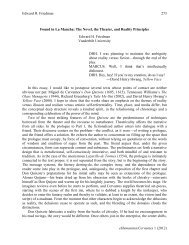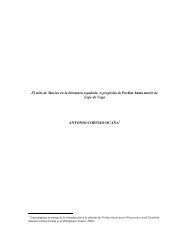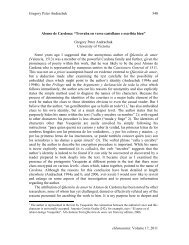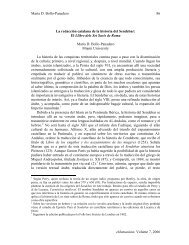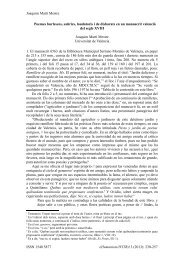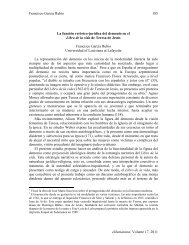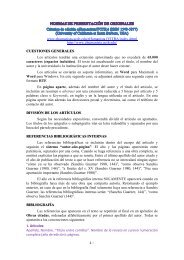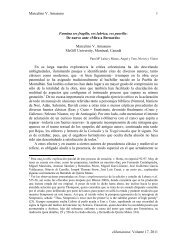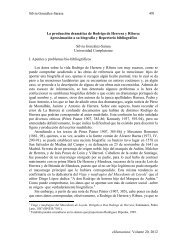Ana Pinto-Muñoz 376 eHumanista: Volume 19, 2011 Roxolana in ...
Ana Pinto-Muñoz 376 eHumanista: Volume 19, 2011 Roxolana in ...
Ana Pinto-Muñoz 376 eHumanista: Volume 19, 2011 Roxolana in ...
You also want an ePaper? Increase the reach of your titles
YUMPU automatically turns print PDFs into web optimized ePapers that Google loves.
<strong>Ana</strong> <strong>P<strong>in</strong>to</strong>-<strong>Muñoz</strong> <strong>376</strong><br />
<strong>Roxolana</strong> <strong>in</strong> the Spanish Golden Age<br />
<strong>Ana</strong> <strong>P<strong>in</strong>to</strong>-<strong>Muñoz</strong><br />
Universidad Complutense (Madrid)<br />
History has not been generous with facts concern<strong>in</strong>g the orig<strong>in</strong> of Hürrem, “the<br />
favorite concub<strong>in</strong>e” of Suleyman the Magnificent. Accord<strong>in</strong>g to some scholars<br />
(Howard <strong>19</strong>3), she was born <strong>in</strong> Poland around 1500 and her orig<strong>in</strong>al name was<br />
Alexandra Lisowska. She was supposed to have either been bought or taken as a slave<br />
by the Ottomans <strong>in</strong> any of their raids <strong>in</strong>to Christian territories. Though Hürrem’s<br />
Christian orig<strong>in</strong> and her <strong>in</strong>itial status of slave <strong>in</strong> the sultan’s harem are accepted by<br />
most, there are scholars (Karpat 756) who say that she was a native of Ukra<strong>in</strong>e. This<br />
hypothesis is backed by Yermolenko: 1<br />
<strong>Roxolana</strong> is believed to have been born <strong>in</strong> the western part of Ukra<strong>in</strong>e<br />
around 1505. Sometime between 1515 and 1520, when she was around 15<br />
years of age, she was abducted by the Crimean Tatars <strong>in</strong> one of their slave<br />
raids on Ukra<strong>in</strong>e. […] and accord<strong>in</strong>g to a legend was purchased for the<br />
imperial harem by Ibrahim Pasha, the close friend of the young Crown<br />
Pr<strong>in</strong>ce Suleiman. (2)<br />
However, suppositions about her life became facts once she was made the favorite<br />
concub<strong>in</strong>e of Suleyman (r. 1520-66). In Turkish sources she is mentioned by the name<br />
of Hürrem, while <strong>in</strong> the Western world she will be known by the names of Roxelana,<br />
<strong>Roxolana</strong>, Rosa Solimana, Rosa or Rossa. Her official status and her <strong>in</strong>fluence over<br />
Suleyman seems to have been considerable for, break<strong>in</strong>g with Ottoman tradition, the<br />
Sultan decided to marry her, which provoked the consequent scandal among his<br />
subjects (Imber 90). Such was Suleyman’s affection for Hürrem that, <strong>in</strong> a break with<br />
custom, she was not to leave Constant<strong>in</strong>ople to accompany her sons to their<br />
governorships <strong>in</strong> the prov<strong>in</strong>ces, but rema<strong>in</strong>ed there at the center of power with<br />
immediate access to the Sultan. The Topkapi palace was her permanent residence.<br />
And as a last token of Suleyman’s affection for her, when she died <strong>in</strong> 1558, she was<br />
buried <strong>in</strong> the grounds of Süleymaniye Mosque, next to the Sultan’s own mausoleum.<br />
Accord<strong>in</strong>g to Western sources (Mcjannet 143), once <strong>Roxolana</strong> ensured her<br />
position by marry<strong>in</strong>g the Sultan, she plotted with the help of Vizier Rustan, who was<br />
married to one of her daughters, aga<strong>in</strong>st Mustapha, Suleyman’s eldest son, whose<br />
mother was another concub<strong>in</strong>e. It seems that she aimed to get rid of Mustapha and<br />
place one of her sons as the Sultan’s heir. This is <strong>in</strong> essence the version given by a<br />
contemporary European, whose name was Ogier Ghisel<strong>in</strong> de Busbecq (1522-92). His<br />
1 To Yermolenko’s book the author of this article has contributed the foreword and translation The<br />
Second Part of the Pontifical and Catholic History (1606) by Gonzalo de Illescas and the foreword and<br />
translation of Lope de Vega’s The Holy League (1603).<br />
<strong>eHumanista</strong>: <strong>Volume</strong> <strong>19</strong>, <strong>2011</strong>
<strong>Ana</strong> <strong>P<strong>in</strong>to</strong>-<strong>Muñoz</strong> 377<br />
book about the Ottomans, which is a collection of letters orig<strong>in</strong>ally written <strong>in</strong> Lat<strong>in</strong> <strong>in</strong><br />
1554, was translated <strong>in</strong>to vernacular languages 2 and circulated widely throughout the<br />
Western world. De Busbecq was well acqua<strong>in</strong>ted with the Ottoman imperial court,<br />
s<strong>in</strong>ce he was ambassador of the Holy Roman Emperor to the Sublime Porte, a post that<br />
he kept from 1554 until 1562.<br />
Mustapha’s death, as suggested by De Busbecq, though ordered by Suleyman, who<br />
was ultimately responsible for any crucial decision, 3 was attributed by his subjects to<br />
the <strong>in</strong>fluence that <strong>Roxolana</strong> exerted on him through the use of spells and magic<br />
potions and to Vizier Rustan. Possibly people were made to believe so by Rustan<br />
himself <strong>in</strong> order to divert blame from Suleyman and to boost the army’s morale with<br />
the <strong>in</strong>tention of prevent<strong>in</strong>g a possible upris<strong>in</strong>g:<br />
[Una vez muerto Mustafá] en todo el real hubo general luto por muchos<br />
días; y durara mucho más (porque no había talle de otra cosa) si no<br />
hubiera desterrado Solimán, y enviado a Constant<strong>in</strong>opla a Rustan, privado<br />
de su cargo (a lo que se deja entender, por consejo del mismo Rustan), en<br />
cuyo lugar y oficio fue proveído Achmat Bajá, el cual era el primero<br />
después de Rustan entre los visires; hombre de más ánimo que consejo.<br />
Esta mudanza aplacó los ánimos de los soldados, y teniendo por creído<br />
(según es el vulgo crédulo) que ya Solimán había caído, aunque tarde, en<br />
la cuenta de las maldades de Rustan y de los bebedizos y hechicerías de su<br />
mujer, y por eso lo había echado de cabe sí, y cuando volviese a<br />
Constant<strong>in</strong>opla tomaría venganza también de la mujer. (De Busbecq 29r<br />
and 29v)<br />
Nowhere <strong>in</strong> the book, though, when speak<strong>in</strong>g of <strong>Roxolana</strong>, does De Busbecq mention<br />
her beauty. Maybe this was due to the fact that such a quality was someth<strong>in</strong>g taken for<br />
granted and a s<strong>in</strong>e qua non for the <strong>in</strong>clusion of a woman <strong>in</strong> the Sultan’s harem. Thus, it<br />
is only her <strong>in</strong>fluence on Suleyman that is emphasized <strong>in</strong> the book. The same happens<br />
<strong>in</strong> Giovio’s book, which is another Western source for the Ottomans. <strong>Roxolana</strong>, under<br />
the name of Rossa, appears as Soliman’s [sic] wife <strong>in</strong> Mustapha, a play written by the<br />
English Fulke Greville (Rees) around 1596. And it is also her <strong>in</strong>fluence on the Sultan<br />
because of her magical powers that is emphasized by this drama.<br />
However, it seems certa<strong>in</strong> that <strong>Roxolana</strong> was a woman of great beauty and,<br />
accord<strong>in</strong>g to various pieces of circumstantial evidence, she deserved to be pa<strong>in</strong>ted by<br />
the great Venetian pa<strong>in</strong>ter Titian. In his book on Titian, Beroqui affirms: “Seguro es,<br />
2 The Spanish translation was published <strong>in</strong> 1610. Quotations from De Busbecq will be given from this<br />
edition. There also exists an English translation, though it was published much later.<br />
3 Based on De Busbecq’s evidence, it seems clear that, <strong>in</strong> spite of <strong>Roxolana</strong> and Rustan’s <strong>in</strong>fluence on<br />
Suleyman, the Sultan had the last word on important matters. When talk<strong>in</strong>g about the Sultan’s future<br />
heir, De Busbecq says that (<strong>in</strong> spite of <strong>Roxolana</strong>’s preference for Bayazid) “mas al fín se habrá de hacer<br />
lo que el padre quiere, que está muy firme y puesto en que no re<strong>in</strong>e después de él otro que Selim, si<br />
fuere vivo” (100v-01r).<br />
<strong>eHumanista</strong>: <strong>Volume</strong> <strong>19</strong>, <strong>2011</strong>
<strong>Ana</strong> <strong>P<strong>in</strong>to</strong>-<strong>Muñoz</strong> 378<br />
pues, lo dicen Vasari y Ridolfi, que el Vecellio [Tiziano] retrató a Rossa, 4 mujer del<br />
Gran Turco [...]; y seguro es, también, que [el retrato] v<strong>in</strong>o a España” (144). The<br />
Spanish playwright Lope de Vega was not the only one to be impressed by her<br />
portrait, as can be <strong>in</strong>fered from what he says <strong>in</strong> his La Dorotea, but many other<br />
people 5 who had witnessed her beauty were impressed as much. In a dialogue between<br />
two characters (Ludovico and Fernando) belong<strong>in</strong>g to that play, we can read:<br />
―Más hermosa muger no la p<strong>in</strong>tó el Ticiano, aunque entre Rosa Solimana, la<br />
favorecida del Turco. [sic]<br />
―¿No pudiérais dezir Sophonisba, Atalanta o Cleopatra?<br />
―Éssas no las p<strong>in</strong>tó el Ticiano.<br />
―Bien dezís, que este retrato le auemos todos visto. (238)<br />
The orig<strong>in</strong>al portrait by Titian has been lost, but –as Suida (168) po<strong>in</strong>ted out and<br />
reproduced <strong>in</strong> <strong>19</strong>49– it is very possible that a portrait <strong>in</strong> The R<strong>in</strong>gl<strong>in</strong>g Museum of<br />
Sarasota (US) could be an identical copy of Titian’s orig<strong>in</strong>al work. Some years later,<br />
De Armas (349) did not hesitate to assume that a copy of <strong>Roxolana</strong> portrait by Titian,<br />
though <strong>in</strong> very poor condition, was kept <strong>in</strong> The R<strong>in</strong>gl<strong>in</strong>g Museum of Art <strong>in</strong> Sarasota,<br />
Florida.<br />
Both <strong>Roxolana</strong>’s beauty and her magical powers are two features of <strong>Roxolana</strong>’s<br />
mentioned by other Western sources. Though not so close to the Ottoman court as De<br />
Busbecq, although he lived dur<strong>in</strong>g Suleyman’s lifetime, the Spanish cleric Gonzalo de<br />
Illescas (1521-74) refers <strong>in</strong> his history to these two characteristics of <strong>Roxolana</strong>’s when<br />
speak<strong>in</strong>g of Suleyman’s wife:<br />
Pero estorbábanle extrañamente el hacerlo [...] <strong>Roxolana</strong> su nueva mujer,<br />
que la había poco antes tomado, y tenía ya hijos de ella. La cual le tenía<br />
tan cautivo con su hermosura, y aun (según dicen) con sus hechicerías y<br />
encantamientos, que no le dejaba salir de Constant<strong>in</strong>opla, a lo menos para<br />
irse muy lejos de ella. (262r)<br />
Given the attraction that Europe felt for a historical figure like Suleyman the<br />
Magnificent, it is difficult to understand why certa<strong>in</strong> facts hav<strong>in</strong>g to do with him were<br />
very soon distorted <strong>in</strong> the Western world. Lope de Vega <strong>in</strong> Spa<strong>in</strong> (1562-1635) is a<br />
case <strong>in</strong> po<strong>in</strong>t.<br />
4 In his edition of La Dorotea by Lope de Vega Morley <strong>in</strong>dicates: “A esta Rosa o Rossa (es decir, rusa,<br />
por su origen) se la llama con frecuencia <strong>Roxolana</strong>” (238). Quotations from this play will be given from<br />
this edition.<br />
5 The famous poet Quevedo (1580-1645), who was also known for his love of pa<strong>in</strong>t<strong>in</strong>g (Candelas-<br />
Colodrón), was also impressed by the portrait: “Entre sus dedos vimos/ nacer segunda vez, y más<br />
hermosa,/ aquella s<strong>in</strong> igual gallarda Rosa,/ que tantas veces de la fama oímos” (135).<br />
<strong>eHumanista</strong>: <strong>Volume</strong> <strong>19</strong>, <strong>2011</strong>
<strong>Ana</strong> <strong>P<strong>in</strong>to</strong>-<strong>Muñoz</strong> 379<br />
It was well known <strong>in</strong> Lope de Vega’s lifetime what type of monarch Suleyman had<br />
been, for Western chronicles of the time, when deal<strong>in</strong>g with this historical figure,<br />
praise his courage and magnanimity, and do not spare laudatory expressions to<br />
describe him both as a man and ruler. He was also considered an enemy of<br />
Christendom who had to be brought to a halt. For <strong>in</strong>stance, De Busbecq provided the<br />
follow<strong>in</strong>g biographical sketch:<br />
De Solimán por ventura me preguntará V.M. qué es lo que me pareció.<br />
Está ya viejo, tiene la cara y presencia dignas de tanta majestad y<br />
grandeza. Siempre estuvo en op<strong>in</strong>ión de cuerdo y templado, aun en la edad<br />
que conforme a su usanza podía pecar y vivir más desenvueltamente, s<strong>in</strong><br />
reprensión; porque ni en su mocedad se dio al v<strong>in</strong>o, ni fue aficionado a<br />
muchachos, que suelen ser los regalos y entretenimientos de los turcos; ni<br />
con razón le pueden achacar aun sus propios enemigos cosa que entre más<br />
en hondo que el ser demasiado rendido y sujeto a su mujer. (55r)<br />
As far as Gonzalo de Illescas is concerned, his praises of Suleyman are even<br />
higher than De Busbecq’s, as can be seen <strong>in</strong> the follow<strong>in</strong>g excerpt referr<strong>in</strong>g to the<br />
Sultan’s death:<br />
Murió este valeroso Príncipe sobre la ciudad de Ciguet, c<strong>in</strong>co días del mes<br />
de septiembre de este año de sesenta y seis. Estúvose secreta su muerte por<br />
algunos respetos, y antes que se publicase ganaron los suyos la ciudad.<br />
Falleció Solimán en edad de sesenta y seis años, habiendo cuarenta y siete<br />
que re<strong>in</strong>aba en Constant<strong>in</strong>opla, con grandísima gloria y majestad, por<br />
haber sido siempre excelentísimo capitán, muy diestro y bien afortunado<br />
en las cosas de la guerra, y muy prudente en las cosas de la paz y<br />
gobernación de sus Re<strong>in</strong>os y amplísimo patrimonio, el cual ensanchó<br />
grandemente, ganando de la parte de Hungría a Belgrado, y a Buda, y<br />
otras muchas y muy importantes plazas de la Cristiandad. Y por parte del<br />
mar Mediterráneo, la <strong>in</strong>signe isla y ciudad de Rodas. Fue hombre de muy<br />
buen entendimiento, y codicioso de ensanchar sus estados tanto como cada<br />
uno de sus antecesores, y grandísimo enemigo del nombre Cristiano, como<br />
por nuestros pecados lo habemos probado muchas veces los que ahora<br />
vivimos. (349r)<br />
When Suleyman died, the Spanish playwright Lope de Vega was four years old<br />
and the reign<strong>in</strong>g sultan at the time was Selim II, Suleyman’s son by <strong>Roxolana</strong>.<br />
However, it will be absurd to assume that such a learned and well <strong>in</strong>formed writer as<br />
Lope de Vega would not have known about the existence of Suleyman and his special<br />
relationship with <strong>Roxolana</strong>. Consequently, it is puzzl<strong>in</strong>g to f<strong>in</strong>d that <strong>in</strong> La Santa Liga 6<br />
6 Quotations from this work will be given accord<strong>in</strong>g to Arroyo-Stephens’ edition.<br />
<strong>eHumanista</strong>: <strong>Volume</strong> <strong>19</strong>, <strong>2011</strong>
<strong>Ana</strong> <strong>P<strong>in</strong>to</strong>-<strong>Muñoz</strong> 380<br />
–one of Lope de Vega’s historical plays– three glar<strong>in</strong>g historical errors occur which<br />
we th<strong>in</strong>k happen on purpose. First, there is no mention of the name of Selim’s father;<br />
second, <strong>Roxolana</strong> –<strong>in</strong> the play either Rosa or Rosa Solimana– is the name given to<br />
Selim’s favorite concub<strong>in</strong>e; and third, the Venetian pa<strong>in</strong>ter Titian, another character <strong>in</strong><br />
the play, appears <strong>in</strong> a scene before the Venetian Senate the day of his arrival from<br />
Constant<strong>in</strong>ople and moments before Selim’s ambassadors unexpectedly made their<br />
entrance.<br />
La Santa Liga was written between 1598 and 1603 7 and the action of the play<br />
recreates both the splendor of the Ottoman Empire and its defeat by the European<br />
powers. The play opens with various scenes <strong>in</strong> the Sultan’s palace <strong>in</strong> Constant<strong>in</strong>ople<br />
and closes with the battle of Lepanto, where an alliance of Christian forces, called the<br />
Holy League, puts a stop –at least temporarily– to the Ottoman naval supremacy <strong>in</strong> the<br />
Mediterranean. On the whole, the action of the play and the ma<strong>in</strong> characters match<br />
historical events and figures.<br />
It is a historical fact, for <strong>in</strong>stance, as stated <strong>in</strong> the play, that the fact that triggered<br />
the Battle of Lepanto <strong>in</strong> 1571 was the occupation of the island of Cyprus by the Turks,<br />
an island that had been until then <strong>in</strong> Venetian hands. Regard<strong>in</strong>g the real reasons that<br />
the Ottomans had for the conquest of the island of Cyprus, most historians agree that<br />
the Venetian control of this island and others, like Crete, implied a threat to the<br />
Ottoman Empire <strong>in</strong> the Eastern Mediterranean. Given that the reign<strong>in</strong>g Sultan was<br />
Selim II (r. 1566-74), Suleyman I’s son and heir, who was very fond of all k<strong>in</strong>ds of<br />
sensual pleasures, w<strong>in</strong>e <strong>in</strong>cluded, and that his early policy towards Christendom was<br />
based on non-aggression, there are some historians (Shaw 13) who suggest that <strong>in</strong><br />
order to allow the conquest of Cyprus the Sultan had to be persuaded by a frivolous<br />
argument, as was the reputation of Cyprus for v<strong>in</strong>tage w<strong>in</strong>e. Selim II’s reticence to<br />
wage war aga<strong>in</strong>st Christendom and his modus operandi to break the truce with Venice<br />
are historical facts accurately portrayed <strong>in</strong> La Santa Liga. All this <strong>in</strong> turn means that<br />
Lope de Vega was well documented <strong>in</strong> historical sources. That is, the <strong>in</strong>formation<br />
extracted from the play matches that provided by historical accounts. For <strong>in</strong>stance, this<br />
is Gonzalo de Illescas’ record of the aforementioned event:<br />
Un poco antes que se levantasen los moriscos de Granada, comenzó el<br />
Gran Turco Selim II, nuestro adversario, a moverse contra la Cristiandad y<br />
a darnos la molestia ord<strong>in</strong>aria que sus pasados acostumbraron a<br />
procurarnos. No había hecho jornada n<strong>in</strong>guna importante en todo el<br />
tiempo de su imperio, de que no poco sosiego se había causado de la<br />
república cristiana [...]. En el mar de Suria bien cerca de la Tierra Santa<br />
tenía la República de Venecia de muchos años atrás la isla de Chipre, y<br />
conservábanla con estar metida de todas partes en medio de las tierras del<br />
Turco, así por el gran valor que aquella República siempre tuvo en<br />
conservar sus tierras, como porque de muchos años atrás, como ya se ha<br />
7 These two dates are tentatively given by Morley & Bruerton 236.<br />
<strong>eHumanista</strong>: <strong>Volume</strong> <strong>19</strong>, <strong>2011</strong>
<strong>Ana</strong> <strong>P<strong>in</strong>to</strong>-<strong>Muñoz</strong> 381<br />
dicho, estaban en paz con el Turco y duraba entre ellos el asiento y<br />
concordia que Solimán asentó con Venecia, y el mismo Selim la había<br />
confirmado y jurado de nuevo de guardarla. Estaban con esto los<br />
venecianos muy seguros, s<strong>in</strong> pensar que de parte de Selim se les había de<br />
dar desasosiego [...]. [F]ue así que Selim, por consejo de sus amigos y<br />
vasallos, determ<strong>in</strong>ó romper la tregua que con Venecia tenía. Para tener<br />
ocasión de romperla, envió al Senado sus embajadores pidiéndoles que s<strong>in</strong><br />
dilación le entregasen la isla de Cypro [sic] que le pertenecía como cosa<br />
que había sido de los Reyes de Jerusalén, cuyo re<strong>in</strong>o, él y sus antecesores,<br />
habían ganado en justa guerra [...], apercibiéndoles que si no se la<br />
entregaban luego, se la quitaría por fuerza y tendría por rompida la tregua<br />
que con ellos había asentado. Esta demanda tan <strong>in</strong>justa turbó extrañamente<br />
al Duque y al Senado veneciano, y después de algunos comedimientos que<br />
con el Turco usaron, representándole la poca razón que tenía de pedir lo<br />
que no era suyo, ni de romper las capitulaciones que con ellos tenía<br />
puestas y juradas, s<strong>in</strong> haberle dado ellos ocasión n<strong>in</strong>guna para hacerles la<br />
guerra, f<strong>in</strong>almente se v<strong>in</strong>ieron a resolver en que no entendían darle lo que<br />
s<strong>in</strong> contradicción era suyo, antes pensaban defenderlo con las armas en<br />
caso que porfiase a quererlos despojar de su hacienda. (351v-52r)<br />
Illescas does not speak about Selim II’s nature and it seems then evident that Lope<br />
de Vega must have used other historical sources for his protrayal of the personal<br />
features of this Sultan. It is a well known fact that Selim II took little <strong>in</strong>terest <strong>in</strong> the<br />
government of his empire, which was handed over to his favorites, and that he devoted<br />
himself to a life of pleasure and sensuality (Shaw 13). Consider<strong>in</strong>g that all these traits<br />
are accurately depicted <strong>in</strong> La Santa Liga, it seems rather puzzl<strong>in</strong>g that <strong>in</strong> one of the<br />
first scenes of the play –after Selim refuses to hear his viziers’ advise to abandon his<br />
easy life– Selim’s father (who appears as a shadow) is not named:<br />
Deténte, aguarda: ¿dónde huyes, sombra?<br />
Y si eres alma, aguarda un poco, espera.<br />
Selín tu hijo soy, Selín te nombra.<br />
Padre, ¿por qué te vas de esa manera?<br />
Cuanto miro parece que me asombra;<br />
todo me causa horror, todo me altera. (495)<br />
We must add that <strong>in</strong> the play the name “Solimán” appears twice, although this<br />
name does not refer to the historical Suleyman on either occasion. The first time, the<br />
name “Solimán” is used by Mustapha, who acts as Selim’s ambassador with the<br />
mission to claim the island of Cyprus, when address<strong>in</strong>g the Venetian Senate. Although<br />
the mean<strong>in</strong>g of the word is not clear at first sight, from the context it could be <strong>in</strong>ferred<br />
<strong>eHumanista</strong>: <strong>Volume</strong> <strong>19</strong>, <strong>2011</strong>
<strong>Ana</strong> <strong>P<strong>in</strong>to</strong>-<strong>Muñoz</strong> 382<br />
that “Solimán” stands for either “musulmán” (“Muslim”) or “grand.” These are<br />
Mustapha’s words when he is <strong>in</strong>vited to take a seat:<br />
Estad, Senado, atento:<br />
Selín, Sultán Solimán<br />
de la gran casa otomana,<br />
señor de lo más del mundo por mares y tierras tantas,<br />
a vos, Senado y famosa<br />
República veneciana,<br />
salud, amistad y paz;<br />
a nuestros profetas, gracias. (594)<br />
On the second occasion, the name appears at the end of the play and is <strong>in</strong>cluded <strong>in</strong> the<br />
lyrics of a song recited by two Spanish rogues who celebrate the victory of Lepanto:<br />
¡Muera el perro Solimán!<br />
¡Vivan Felipe y don Juan!<br />
¡Viva Felipe famoso<br />
y el gran don Juan glorïoso,<br />
que por venir victorioso<br />
la palma y laurel le dan!<br />
¡Muera el perro Solimán!<br />
¡Viva don Juan dos mil años!<br />
Y al Gran Turco lleve el diablo;<br />
hágale Judas el plato<br />
con pólvora y alquitrán.<br />
¡Muera el perro Solimán!<br />
¡Vivan Felipe y don Juan! (564-65)<br />
Consider<strong>in</strong>g the low social orig<strong>in</strong> of these two characters, the word “Solimán” <strong>in</strong> their<br />
lips could imply that for ord<strong>in</strong>ary people that name could be equated with the word<br />
“sultan,” for it was thanks to the great Suleyman I –known by the name Soliman at the<br />
time– that the knowledge of the Ottoman Empire spread throughout the Western<br />
world. And both names, “Solimán” and “sultán,” have a certa<strong>in</strong> phonetic similarity <strong>in</strong><br />
Spanish. At the same time, the mention of the name “Solimán” at this precise moment<br />
could serve two additional purposes. On the one hand, it allows the playwright to<br />
contrast the name of don Juan with that of Solimán by means of a co<strong>in</strong>cidence <strong>in</strong><br />
rhyme (end<strong>in</strong>g). On the other hand, denigrat<strong>in</strong>g and manipulat<strong>in</strong>g the name “Solimán”<br />
while prais<strong>in</strong>g that of don Juan could be an attempt to make people believe that the<br />
past splendor of the Ottoman Empire had been overturned. After the Ottoman defeat <strong>in</strong><br />
the battle of Lepanto at the hands of the Holy League led by don Juan of Austria, it<br />
was now time for Spa<strong>in</strong>’s imperial glory, as the song clearly suggests.<br />
<strong>eHumanista</strong>: <strong>Volume</strong> <strong>19</strong>, <strong>2011</strong>
<strong>Ana</strong> <strong>P<strong>in</strong>to</strong>-<strong>Muñoz</strong> 383<br />
It is also a historical fact that Selim II had a favorite concub<strong>in</strong>e whose name was<br />
Nurbanu and that, follow<strong>in</strong>g <strong>in</strong> his father’s footsteps, he took her as his legal wife.<br />
Unlike Hürrem, Nurbanu (d. 1583) outlived Selim II and, from 1574 until her death,<br />
she enjoyed a political role as mother of the reign<strong>in</strong>g sultan. For it was her own son,<br />
known by the name Murad III (1574-95), who would succeed Selim II. However, <strong>in</strong><br />
La Santa Liga the name of Rosa Solimana is given to Selim’s favorite concub<strong>in</strong>e.<br />
Inevitably the follow<strong>in</strong>g question arises: Why did Lope de Vega choose this particular<br />
name which sounded so closely to ‘Suleyman,’ for the word “Solimana” was a<br />
derivative of “Solimán,” that is, it conta<strong>in</strong>ed or <strong>in</strong>cluded the name of this sultan? A<br />
possible answer could be that “Solimana” had the <strong>in</strong>valuable advantage of hav<strong>in</strong>g been<br />
made famous as the name of a historical sultana (thanks to Suleyman I). Another<br />
possible reason could be that the audience of the play, who were for the most part<br />
ignorant of history, would be easily <strong>in</strong>duced to believe that the name Solimana meant<br />
“Muslim woman,” “Ottoman woman”, “sultana,” or even that a word composed of sol<br />
“sun” + –mana (a similar end<strong>in</strong>g as <strong>in</strong> musulmana, “Muslim woman,” or otomana,<br />
“Ottoman woman”) suggested the beauty attributed to the character <strong>in</strong> the play due to<br />
the connotations that the word sol has <strong>in</strong> Spanish. While distort<strong>in</strong>g history by misus<strong>in</strong>g<br />
the name of Suleyman’s wife the playwright possibly had <strong>in</strong> m<strong>in</strong>d other <strong>in</strong>terests, and<br />
keep<strong>in</strong>g alive this brilliant sultan’s memory or be<strong>in</strong>g faithful to historical facts<br />
concern<strong>in</strong>g his life were not among them.<br />
The third historical <strong>in</strong>accuracy <strong>in</strong> La Santa Liga was to <strong>in</strong>clude Titian as one of the<br />
characters of the play. The Venetian pa<strong>in</strong>ter appears <strong>in</strong> a scene which opens at the<br />
Venetian Senate, moments after his arrival from Constant<strong>in</strong>ople, where the Sultan had<br />
commissioned him to pa<strong>in</strong>t Rosa Solimana’s portrait, who, accord<strong>in</strong>g to the play, is<br />
Selim’s favorite concub<strong>in</strong>e and has enthralled him with her beauty. In 1570, the year<br />
when the island of Cyprus was taken by the Turks, the Venetian pa<strong>in</strong>ter was still alive<br />
(he died six years later, <strong>in</strong> 1576). But he could not have pa<strong>in</strong>ted the historical figure<br />
known as Hürrem or Rosa Solimana –Suleyman I’s wife and Selim II’s mother– at this<br />
date for she had died <strong>in</strong> 1558, that is, twelve years before. And, as it has already been<br />
po<strong>in</strong>ted out, historical evidence shows (Beroqui; Suida; Armas) that Titian made a<br />
portrait of the historical figure known as Hürrem or Rosa Solimana, although it is<br />
highly uncerta<strong>in</strong> whether the Venetian pa<strong>in</strong>ter traveled to Constant<strong>in</strong>ople at the time of<br />
Suleyman I <strong>in</strong> order to pa<strong>in</strong>t her portrait (Sandoval).<br />
However, when Titian appears <strong>in</strong> La Santa Liga he has just come to Venice from<br />
Selim’s court, br<strong>in</strong>g<strong>in</strong>g a copy of the portrait of Rosa Solimana, Sultan Selim’s<br />
favorite concub<strong>in</strong>e. He is welcomed by the Venetian Senate moments before the<br />
arrival of Selim’s ambassadors whose mission will be to claim the island of Cyprus.<br />
The pa<strong>in</strong>ter is welcomed by one of the Senators with the follow<strong>in</strong>g words:<br />
Seáis muy bien venido a vuestra patria,<br />
p<strong>in</strong>tor famoso, gran Ticiano ilustre,<br />
honor del siglo antiguo y el moderno. (503)<br />
<strong>eHumanista</strong>: <strong>Volume</strong> <strong>19</strong>, <strong>2011</strong>
<strong>Ana</strong> <strong>P<strong>in</strong>to</strong>-<strong>Muñoz</strong> 384<br />
Upon this salute, the pa<strong>in</strong>ter addresses them by say<strong>in</strong>g:<br />
Senado veneciano excelentísimo,<br />
por vuestro gusto fui a Constant<strong>in</strong>opla,<br />
que Selín os pidió que me enviásedes<br />
a retratar a Rosa Solimana,<br />
contra los ritos de su <strong>in</strong>fame secta;<br />
retratéla, servíle y, bien pagado,<br />
vuelvo a mi patria y esta carta os traigo. (503)<br />
The contents of the Sultan’s letter are made known by another senator:<br />
Selín, Sultán por la gracia de Dios, Emperador de Constant<strong>in</strong>opla, etc., a<br />
vos, el noble Senado y República veneciana: las paces que el año pasado<br />
juré con vosotros vuelvo a jurar de nuevo, para que hasta mis herederos<br />
queden <strong>in</strong>violables. Del Ticiano, vuestro p<strong>in</strong>tor famoso, quedo bien<br />
servido; pídoos encarecidamente le hagáis noble, pues ni por el arte lo<br />
desmerece, ni su virtud me obliga menos que a pedíroslo. Dios os guarde.<br />
(503)<br />
All these historical <strong>in</strong>accuracies do not seem to happen by chance or the author’s<br />
mis<strong>in</strong>formation. On the contrary, they appear to have been deliberately planned.<br />
However, before advanc<strong>in</strong>g any hypothesis, we should remember that these<br />
anachronisms are <strong>in</strong>cluded <strong>in</strong> a dramatic work meant to be enjoyed by a large public.<br />
But besides enterta<strong>in</strong>ment Lope de Vega could be add<strong>in</strong>g another <strong>in</strong>gredient to his<br />
play: <strong>in</strong>doctr<strong>in</strong>ation. It must be stressed, as Renuncio-Roba (207) does <strong>in</strong> his own<br />
study on La Santa Liga, that Lope de Vega is the creator of the so-called “new<br />
comedy” or “national comedy,” a successful type of theatre largely <strong>in</strong>tended for<br />
enterta<strong>in</strong>ment. In addition, Lope de Vega and other contemporary writers helped with<br />
their works to re<strong>in</strong>force the values that made up the Spanish national consciousness,<br />
values that logically were championed by the two great <strong>in</strong>stitutions of the time: the<br />
Catholic Church and the Monarchy.<br />
Hav<strong>in</strong>g <strong>in</strong> view these considerations, it may be better expla<strong>in</strong>ed that a historical<br />
drama, like La Santa Liga, could alter historical facts if these suited the author’s<br />
ideological purpose. In La Santa Liga, Lope de Vega attempts to blur out Suleyman<br />
the Magnificent’s memory. First by distort<strong>in</strong>g history <strong>in</strong> relation to his wife Rosa<br />
Solimana, and second by manipulat<strong>in</strong>g his name <strong>in</strong> contexts that contribute to damage<br />
his prestige. For Suleyman is mentioned <strong>in</strong> derogatory terms after the defeat of the<br />
sultan’s army at Lepanto, as the lyrics by the two rogues’ song at the end of the play<br />
<strong>in</strong>dicate (see above). The playwright’s aim is to stress the grandeur of Spa<strong>in</strong> for his<br />
audience, whose k<strong>in</strong>g, Philip II, a staunch advocate of Christianity as the play remarks,<br />
<strong>eHumanista</strong>: <strong>Volume</strong> <strong>19</strong>, <strong>2011</strong>
<strong>Ana</strong> <strong>P<strong>in</strong>to</strong>-<strong>Muñoz</strong> 385<br />
is to be glorified because he has contributed an army and a leader that have been<br />
crucial for the defeat of the Turks at Lepanto.<br />
The anachronism deal<strong>in</strong>g with Titian is only a poetic liberty taken by the author of<br />
La Santa Liga to show his admiration for the Venetian pa<strong>in</strong>ter, who is mentioned, at<br />
least, fourteen times <strong>in</strong> his works (Herrero-García; Sánchez-Cantón;). It is a known<br />
fact that Lope de Vega was extremely well versed <strong>in</strong> the theory and history of art, as<br />
De Armas has po<strong>in</strong>ted out (338). In addition, various scholars have noted the <strong>in</strong>fluence<br />
of several pa<strong>in</strong>t<strong>in</strong>gs <strong>in</strong> his plays, that is, the existence of a pictorial sense <strong>in</strong> many of<br />
his works (Castro and Rennert; Clements; Sánchez-Jiménez & Olivares).<br />
Did Lope de Vega achieve his objective by alter<strong>in</strong>g some historical facts? In the<br />
short run, he very possibly contributed to darken the great historical figure of<br />
Suleyman I. Concern<strong>in</strong>g Titian, it does not matter much whether the Venetian pa<strong>in</strong>ter<br />
pa<strong>in</strong>ted Hürrem or any other beautiful sultana. The reputation of Titian as a great<br />
pa<strong>in</strong>ter, which Lope de Vega praises <strong>in</strong> the play by the laudatory words addressed to<br />
him by one of the Venetian Senators, has not suffered the slightest change throughout<br />
history. However, the character of Rosa Solimana created by Lope de Vega <strong>in</strong> La<br />
Santa Liga outlived the historical figure of Rosa Solimana, Suleyman I’s wife. Around<br />
the 1630’s, not many years after La Santa Liga was written, a fictional character called<br />
Rosa Solimana appears aga<strong>in</strong> <strong>in</strong> a drama entitled La Baltasara 8 whose role this time<br />
will be to play the part of Sultan Salad<strong>in</strong>’s wife!<br />
La Baltasara 9 is a co-authored play. The first act was written by Luis Vélez de<br />
Guevara (1579-1644). Antonio Coello and Francisco de Rojas were the authors of the<br />
second and third parts respectively. The title derives from the name of a beautiful and<br />
famous actress <strong>in</strong> Madrid <strong>in</strong> the 17th century whose life is dramatized <strong>in</strong> this play.<br />
Only the first act of this play concerns us here. The character played by the actress<br />
represent<strong>in</strong>g Baltasara is no less than Rosa Solimana, wife of Salad<strong>in</strong> (1138-1<strong>19</strong>3),<br />
Sultan of Egypt and Syria. The drama starts with the presence on stage of several<br />
characters announc<strong>in</strong>g The Great Comedy of Salad<strong>in</strong> to be performed and expla<strong>in</strong><strong>in</strong>g<br />
the role that the character represent<strong>in</strong>g actress Baltasara is to have <strong>in</strong> the play. The<br />
action of the play proper takes place <strong>in</strong> the vic<strong>in</strong>ity of Jerusalem <strong>in</strong> the 12 th century.<br />
Salad<strong>in</strong> and his wife Rosa Solimana enter the scene, they gaze at the city from a<br />
8<br />
Quotations from this play will be given accord<strong>in</strong>g to the undated edition at the Biblioteca Nacional<br />
(Madrid).<br />
9<br />
Accord<strong>in</strong>g to a conjecture by Castilla, the play could not have been performed before 1638 or after<br />
1643. In this respect, Castilla says: “Publicada en 1652, en el primer volumen de Comedias nuevas de<br />
los mejores <strong>in</strong>genios de España, La Baltasara pudo haber sido escrita unos diez años antes. Ciertos<br />
datos permiten situar con una cierta aproximación la fecha de su estreno no antes de 1638 ni después de<br />
1643” (371). However, Lobato suggests that Castilla’s dates should be revised consider<strong>in</strong>g that the play<br />
was supposed to have been performed <strong>in</strong> Seville <strong>in</strong> 1636 (20).<br />
<strong>eHumanista</strong>: <strong>Volume</strong> <strong>19</strong>, <strong>2011</strong>
<strong>Ana</strong> <strong>P<strong>in</strong>to</strong>-<strong>Muñoz</strong> 386<br />
distance, and Baltasara <strong>in</strong> her role of Rosa Solimana speaks up challeng<strong>in</strong>g the<br />
followers of Godfrey of Bouillon, the first K<strong>in</strong>g of Jerusalem:<br />
Católicos Palad<strong>in</strong>es,<br />
nobles franceses Bullones,<br />
los que repetís al pecho<br />
la blanca cruz de Godofre:<br />
yo soy Rosa Solimana,<br />
del solimán 10 como soles,<br />
la que vive con su aliento<br />
tan altiva, que se opone<br />
a los estruendos de Marte<br />
y a la saña de sus golpes. (4v)<br />
Both Salad<strong>in</strong> and Rosa Solimana are will<strong>in</strong>g to fight the Christians and they encourage<br />
each other to launch an attack on Jerusalem. While this is happen<strong>in</strong>g and Salad<strong>in</strong><br />
announces his <strong>in</strong>tention to lead his own troops, Rosa Solimana suddenly turns <strong>in</strong>to<br />
Baltasara. That is, the character of Baltasara stops play<strong>in</strong>g the role of Rosa Solimana<br />
and beg<strong>in</strong>s to play the part of the famous beautiful actress called Baltasara. Later she<br />
resumes her role as Rosa Solimana and together with Salad<strong>in</strong> they make plans for<br />
carry<strong>in</strong>g out the military campaign aga<strong>in</strong>st Jerusalem. With that purpose <strong>in</strong> m<strong>in</strong>d they<br />
quit the scene and the first act ends. In the follow<strong>in</strong>g two acts there is no trace of the<br />
characters of Salad<strong>in</strong> and Rosa Solimana. The action will be centered around several<br />
other characters <strong>in</strong>volved <strong>in</strong> the life of the actress Baltasara who will show their<br />
feel<strong>in</strong>gs towards her as they make their entrance <strong>in</strong>to the stage.<br />
*****<br />
Nonetheless, however <strong>in</strong>terest<strong>in</strong>g or amus<strong>in</strong>g the whole plot of this drama might<br />
be, what I wish to highlight is the fact that <strong>in</strong> La Baltasara the character of Rosa<br />
Solimana created by Lope de Vega has outlived the historical figure of Hürrem. 11<br />
Thus Lope de Vega was able to create with his character (Rosa Solimana) a female<br />
figure that encapsulated and epitomized for a 17 th -century audience the most salient<br />
10 It is obvious that the mention of the name “Solimán,” a name given to Salad<strong>in</strong> by his partner <strong>in</strong> this<br />
part of the play, cannot refer to the historical figure Suleyman I. This re<strong>in</strong>forces our idea of the mean<strong>in</strong>g<br />
given to that name by Lope de Vega <strong>in</strong> La Santa Liga (see above).<br />
11 Prior to La Santa Liga, Lope de Vega had used the name of “Rosa Solimana” <strong>in</strong> Los españoles en<br />
Flandes (1620), when Rosela, <strong>in</strong> love with Don Juan de Austria, says: “ Pues si Rosa Solimana, / hija<br />
del turco, os adora, / por la fama que atesora / vuestra virtud soberana; / si vuestros retratos tiene / y os<br />
quiere tanto, s<strong>in</strong> veros, / bárbara, aunque no en quereros, / y a quien a pedirle viene / por la vida de don<br />
Juan / otorga cualquiera cosa, / ¿no seré yo muy dichosa?” (vv. 2237 et ss., Cortijo ed.). Lope de Vega<br />
will mention aga<strong>in</strong> “Rosa Solimana” <strong>in</strong> El rey s<strong>in</strong> re<strong>in</strong>o (1625) and there is a reference to her <strong>in</strong> the<br />
second act of Tanto es lo de más como lo de menos by Tirso de Mol<strong>in</strong>a (1631).<br />
<strong>eHumanista</strong>: <strong>Volume</strong> <strong>19</strong>, <strong>2011</strong>
<strong>Ana</strong> <strong>P<strong>in</strong>to</strong>-<strong>Muñoz</strong> 387<br />
features of the beauty and positive exoticism (<strong>in</strong> a Maurophiliac context [Fuchs]) that<br />
Spanish literature and culture came to identify with the name of sultana. When later<br />
playwrights 12 needed a character to play the role of a 12 th -century sultana they drew<br />
<strong>in</strong>spiration from the character created by Lope de Vega <strong>in</strong> La Santa Liga to embody<br />
Sultan Selim’s favorite lover and did not hesitate to use her same name and personal<br />
and physical features for the character of another sultana who lived four centuries<br />
before Hürrem.<br />
12 As an anecdote, it must be added that it was not only playwrights that were <strong>in</strong>fluenced by the fictional<br />
character of Rosa Solimana created by Lope de Vega <strong>in</strong> La Santa Liga, but also pa<strong>in</strong>ters like Vicenzio<br />
Carducci (1578-1638). This Italian pa<strong>in</strong>ter, who lived <strong>in</strong> Madrid, authored a treatise on pa<strong>in</strong>t<strong>in</strong>g<br />
dedicated to the Spanish K<strong>in</strong>g Philip IV. His book was published <strong>in</strong> 1633, and Carducci (375) accepts<br />
as a true fact the story told by Lope concern<strong>in</strong>g Titian and Selim’s request addressed to the Venetian<br />
Republic request<strong>in</strong>g a noble title for the pa<strong>in</strong>ter as a reward for the portrait he made of his favorite lover<br />
Rosa Solimana.<br />
<strong>eHumanista</strong>: <strong>Volume</strong> <strong>19</strong>, <strong>2011</strong>
<strong>Ana</strong> <strong>P<strong>in</strong>to</strong>-<strong>Muñoz</strong> 388<br />
Works cited<br />
Armas, Frederick A. de. “Lope de Vega and Titian.” Comparative Literature. 30<br />
(<strong>19</strong>78): 338-52.<br />
Beroqui, Pedro. Tiziano en el museo del Prado. Madrid: Talleres tipográficos de<br />
Cándido Bermejo, <strong>19</strong>46.<br />
Candelas-Colodrón, Manuel Ángel. “La Silva “el p<strong>in</strong>cel” de Quevedo: la teoría<br />
pictórica y la alabanza de p<strong>in</strong>tores al servicio del dogma contrarreformista.”<br />
Bullet<strong>in</strong> Hispanique 98 (<strong>19</strong>96): 85-95.<br />
Carducci, Vicenzio. Ed. Gregorio Cruzada-Villaamil. Diálogos de la p<strong>in</strong>tura: su<br />
defensa, origen, esencia, def<strong>in</strong>ición, modos y diferencias. Madrid: Imprenta de<br />
Manuel Galiano, 1865.<br />
Castilla, Alberto. “Seis autores en busca de una actriz: La Baltasara.” Eds. A. David<br />
Kossof et al. Actas del VIII Congreso de la Asociación Internacional de<br />
Hispanistas. Brown University. 22-27 agosto <strong>19</strong>83. Madrid: Istmo, <strong>19</strong>83. I,<br />
367-80.<br />
Castro, Américo & Hugo A. Rennert. Vida de Lope de Vega. Salamanca: <strong>Ana</strong>ya, <strong>19</strong>68.<br />
Clements, Robert J. Picta Poesis. Roma: Edizioni di storia e letteratura, <strong>19</strong>60.<br />
De Busbecq, Ogier Ghisel<strong>in</strong>. Embaxada y viages de Constant<strong>in</strong>opla y Amasea de<br />
Augerio Gislenio Busbequio. Translated from Lat<strong>in</strong> by el L[icenciado] Steban<br />
López de Reta. Dedicated to NUESTRA MADRE HESPAÑA [sic]. Pamplona:<br />
Carlos de Labayen, 1610.<br />
---. The Four Epistles of A. G. Busbecquius Concern<strong>in</strong>g his Embassy <strong>in</strong>to Turkey /<br />
Be<strong>in</strong>g Remarks upon the Religion, Customs, Riches, Strength, and Government<br />
of that People. London, 1694.<br />
Fuchs, Barbara. Exotic Nation: Maurophilia and the Construction of Early Modern<br />
Spa<strong>in</strong>. Philadelphia: University of Pennsylvania Press, 2009.<br />
Giovio, Paolo. Commentarii delle cose de Turchi. Rome, 1535.<br />
Herrero-García, Miguel. Contribución de la literatura a la historia del arte. Madrid:<br />
Instituto Antonio de Lebrija, <strong>19</strong>43.<br />
Howard, Douglas A. A History of Turkey. Westport, Connecticut: Greenwood Press,<br />
2001.<br />
Illescas, Gonzalo de. Historia Pontifical y Catholica. Segunda Parte. Barcelona:<br />
Jaime Cendrat, 1606.<br />
Imber, Col<strong>in</strong>. Ottoman Empire, 1300-1650. The Structure of Power. Gordonsville,<br />
Virg<strong>in</strong>ia: Palgrave Macmillan, 2004.<br />
Karpat, Kemal H. Studies on Ottoman Social and Political History: Selected Articles<br />
and Essays. Leiden: Brill, 2002.<br />
Lobato, M. Luisa. “Puesta en escena de Rojas en el siglo XVII.” Eds. Felipe B.<br />
Pedraza et al. Rojas Zorrilla en escena. XXX Jornadas de Teatro Clásico.<br />
Cuenca: Ediciones de la Universidad Castilla-La Mancha, 2008. 17-44.<br />
<strong>eHumanista</strong>: <strong>Volume</strong> <strong>19</strong>, <strong>2011</strong>
<strong>Ana</strong> <strong>P<strong>in</strong>to</strong>-<strong>Muñoz</strong> 389<br />
Lope de Vega, F. C. Ed. Edw<strong>in</strong> S. Morley. La Dorotea. Madrid: Editorial Castalia,<br />
<strong>19</strong>68 (<strong>19</strong>58).<br />
---. Ed. Manuel Arroyo-Stephens. La Santa Liga <strong>in</strong> Obras Completas. Comedias. Vol<br />
X. Madrid: Biblioteca Castro Turner, <strong>19</strong>94. 477-507.<br />
---. Ed. Antonio Cortijo Ocaña. Los españoles en Flandes. (ProLope). In press.<br />
Mcjannet, L<strong>in</strong>da. Sultan Speaks: Dialogue <strong>in</strong> English Plays and Histories about the<br />
Ottoman Turks. Gordonsville, Virg<strong>in</strong>ia: Palgrave MacMillan. 2006.<br />
Morley, S. Griswold & C. Bruerton. Tr. María Rosa Cartes. Cronología de las<br />
comedias de Lope de Vega. Madrid: Gredos, <strong>19</strong>68.<br />
Quevedo, Francisco. Ed. José Manuel Blecua. Poemas escogidos. Madrid: Editorial<br />
Castalia, <strong>19</strong>89.<br />
Rees, Joan, ed. The Tragedy of Mustapha. In The Selected Writ<strong>in</strong>gs of Fulke Greville.<br />
London: Athlone Press, <strong>19</strong>73.<br />
Sandoval, Prudencio de. Historia de la vida y hechos del Emperador Carlos V.<br />
Pamplona: Bartholome Paris, 1614.<br />
Shaw, M. K. Wendy. Possessors and Possessed: Museums, Archaeology, and the<br />
Visualization of History <strong>in</strong> the Late Ottoman Empire. Berkeley: University of<br />
California Press, 2003.<br />
Renuncio-Roba, Miguel. “El mundo islámico en La Santa Liga de Lope de Vega.”<br />
<strong>Ana</strong>quel de Estudios Árabes. 16 (2005): 205-17.<br />
Sánchez-Cantón, Francisco Javier. Fuentes literarias para la historia del arte español.<br />
Vol 5. Madrid: Centro de Estudios Históricos, <strong>19</strong>41.<br />
Sánchez-Jiménez, Antonio & Julián Olivares. “Lope de Vega y El Greco: Ut pictura<br />
poesis en el Toledo del siglo XVII.” Bullet<strong>in</strong> of Hispanic Studies 88.1 (<strong>2011</strong>):<br />
21-42.<br />
Suida, Wilhelm Emil. A Catalogue of Pa<strong>in</strong>t<strong>in</strong>gs <strong>in</strong> the John & Mabel R<strong>in</strong>gl<strong>in</strong>g<br />
Museum of Art. Sarasota: John and Mabel R<strong>in</strong>gl<strong>in</strong>g Museum of Art, <strong>19</strong>49.<br />
Vélez de Guevara, Luis, Antonio Coello, & Francisco de Rojas. La gran comedia de<br />
la Baltasara. S.l: s.i, s.a. [Madrid: Biblioteca Nacional, A-D2].<br />
Yermolenko, Gal<strong>in</strong>a, ed. <strong>Roxolana</strong> <strong>in</strong> European Literature; History and Culture.<br />
Great Brita<strong>in</strong>: Ashgate, 2010.<br />
<strong>eHumanista</strong>: <strong>Volume</strong> <strong>19</strong>, <strong>2011</strong>



